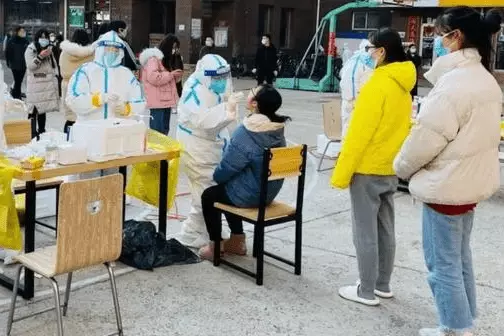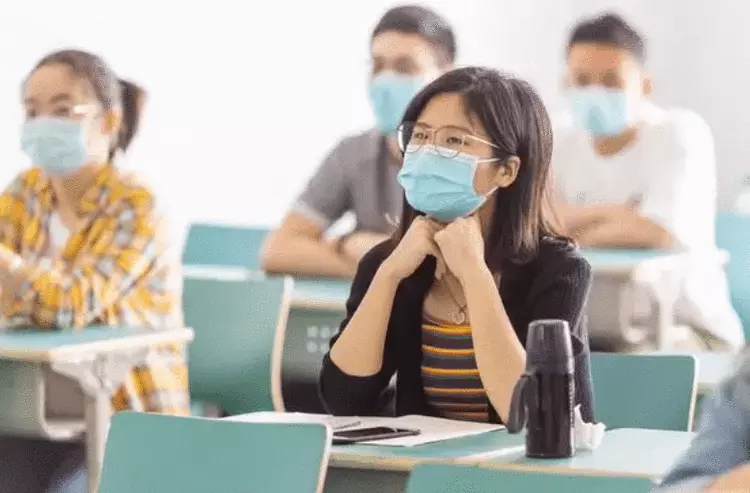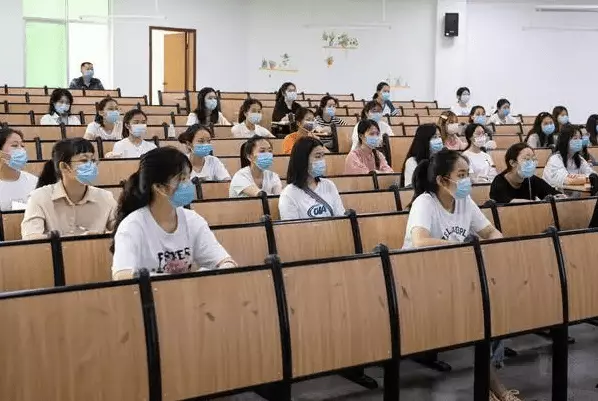
Notice of the Leading Group of the Ministry of Education in Response to Novel Coronavirus Infection on the Issuance of the Work Plan for Prevention and Control of Novel Coronavirus Infection in Schools

File photo
Notice of the Leading Group of the Ministry of Education on the Prevention and Control of Novel Coronavirus Infection in Schools
All provinces, autonomous regions and municipalities directly under the Central Government, the Education Bureau of Xinjiang Production and Construction Corps, the education departments (bureaus) of relevant departments (units), the higher education institutions under the Ministry, and the higher education institutions jointly constructed by the Ministry and provinces.
In order to implement the State Council joint prevention and control mechanism issued by the integrated group “on the implementation of the new coronavirus infection “B class B management of the overall plan”, the Ministry of Education developed a “new coronavirus infection prevention and control work program”, and agreed by the State Council joint prevention and control mechanism integrated group, is issued to you, please follow the implementation of the program.
The Ministry of Education to respond to the new coronavirus infection work leading group
(Ministry of Education on behalf of the seal)
December 27, 2022
Work plan for prevention and control of novel coronavirus infection in schools
In order to scientifically and efficiently coordinate the prevention and control of novel coronavirus infection in schools and education and teaching work, to ensure the safety and health of teachers and students, and to continuously protect the normal order of schools, according to the “General Plan on the Implementation of “Category B B Management” of novel coronavirus infection”, combined with the actual education system, this plan is developed.
I. Adjustment and optimization of campus testing strategy
Higher education institutions no longer carry out full nucleic acid screening, the key personnel on campus in accordance with the relevant provisions of nucleic acid or antigen testing. With the exception of inter-regional return enrollment, higher education students and faculty are not required to provide nucleic acid certificates to enter or leave the campus gates and public areas. Other health screening methods for outsiders entering the campus will be stipulated by the local area or school with the consent of the local area. According to the actual needs and local conditions, primary and secondary schools and kindergartens carry out appropriate nucleic acid testing for teachers and students, such as screening, rotational testing, sampling, etc. Teachers and students are not required to provide nucleic acid certificates to enter and leave the school gates, while other outsiders are required to provide nucleic acid certificates to enter the campus.

Photo
II. Scientific arrangement of education and teaching methods
Schools without an epidemic carry out normal offline teaching activities. During an epidemic, primary and secondary schools and kindergartens are under strict closed management, and higher education schools may implement zoned management. Evacuation measures such as reducing interpersonal contact, implementing online teaching, and adjusting teaching arrangements are taken in a timely manner after an epidemic occurs on campus in higher education schools. In primary and secondary schools, classroom-based measures are proposed and implemented by the county (district) level education administrative department in conjunction with health and disease control departments after the emergence of an infected person. After the emergence of infected persons in kindergartens, temporary closure measures may be taken. After the epidemic is lifted, normal education and teaching should be resumed in a timely manner.
Third, enhance the ability to prevent and control epidemics on campus
During an epidemic at the school site, multiple parties collaborate to prevent the risk of importation and spread of the epidemic, timely detection, treatment and management of infected persons, and control of school-based aggregated epidemics. Local health, disease control and education departments should provide guidance and support to higher education institutions to create conditions for building school health posts, scientifically determine the number of beds according to the number of students and teachers in schools and epidemic prevention needs, equip sufficient medical and service support personnel, medical drugs and equipment, create relatively independent accommodation for asymptomatic infected persons and light cases on campus as needed, and provide temporary health monitoring or appropriate symptomatic treatment and other related services In addition, in the campus dormitory area and other areas where students gather to open fever treatment points to provide fast and convenient medical services. Higher school hospitals should coordinate the management of medical resources across the campus, create conditions to set up fever clinics and isolated consultation areas, implement a 24-hour on-call duty system, publish hotlines or online service windows, and provide medical consultation services for teachers and students. Primary and secondary schools to strengthen the health room (health room) construction, strengthen the professional training of practitioners, equipped with the necessary medical drugs, set up teachers and students health observation room, for fever and other symptoms of teachers and students to provide temporary detention, and guide parents to safely pick up students home.
Fourth, sound professional treatment green channel
The school’s local health, disease control and education departments support the school-site coordination, establish a stable docking mechanism between the school and the relevant hospital, coordinate the local hospital charter school, arrange for hospital medical staff to work together in the school, improve the green channel for transferring relevant cases in the school to the relevant hospital for professional treatment, in accordance with the principle of graded classification of treatment, refine the graded treatment of infected persons in the school, common type cases are referred to sub-determined hospitals Heavy and critical cases with pneumonia as the main manifestation and those requiring hemodialysis will be treated centrally in the designated hospitals; heavy and critical cases with basic diseases will be referred to tertiary hospitals with treatment capability.
V. Do a good job in monitoring the health of teachers and students
Health education is carried out in various forms to guide teachers and students to firmly establish and consciously practice the concept of “health first” and to be the first person responsible for their own health. Adhere to good hygiene habits such as wearing masks and washing hands regularly, strengthen physical exercise, maintain a healthy lifestyle, and improve health literacy and self-protection. Strengthen the health monitoring of teachers and students, measure the temperature of teachers and students when they enter the school, and take appropriate measures such as detention in time when fever is detected. Teachers and students with fever, dry cough, weakness, sore throat and other symptoms are not allowed to work and study at school with illness. Work with the community to conduct a health survey of key populations among teachers and students, build a file and card in a timely manner, and carry out health management. Primary and secondary schools and kindergartens to implement the morning and afternoon check-up system, infectious disease reporting system, absence from school due to illness tracking registration system, etc., to improve the level of disease monitoring and early warning information.
Sixth, strengthen the stockpile of school supplies
Schools are dynamically stockpiling new coronavirus infection-related herbal medicines, symptomatic treatment drugs and antigen detection reagents according to 15-20% of the total population, and schools with a larger population may increase as appropriate. Adequate stockpile of common epidemic prevention supplies such as masks, disinfection supplies, and safety temperature measuring equipment. Epidemic prevention supplies should be kept in reserve for more than one week, and stable supply channels should be established to ensure adequate application in emergency situations. In the event of a large-scale gathering of epidemic in schools, localities should give priority to the supply of school living materials and epidemic prevention materials, and to the treatment of infected persons with special needs in schools.

Photo
Seven, improve public health on campus
Insist on the prevention of people, things and the environment together and the prevention of multiple diseases together. Implement a sanitary management system and disinfection system for public areas on campus. Maintain air circulation in teaching areas, dormitories, public restrooms and other places, and minimize the use of enclosed indoor spaces without natural ventilation. Disinfection supplies are placed at entrances to school buildings, stairway entrances, elevator entrances, etc., and disinfection is done when people enter and exit. Places and schools that are in a position to do so can maintain safe distances by appropriately reducing class sizes and increasing the spacing between tables and chairs. Strengthen personnel management in school cafeterias, libraries, gymnasiums and other public places, and strictly manage large-scale personnel gathering activities. Strengthen the management of food and drinking water safety.
Eight, improve the protection of teachers and students services
Education administrative departments and schools at all levels should pay close attention to the thought dynamics of teachers and students, guide them to correctly understand the epidemic prevention policies and measures, and enhance morale and confidence. Provincial and municipal education departments and colleges and universities should improve the regular “receiving and handling” mechanism, implement the account system for the problems reflected by teachers and students, solve the feedback in a timely manner, and meet the reasonable demands of teachers and students. Encourage schools to issue health prevention kits for teachers and students, identify the number of teachers and students with special health needs and difficulties in life, establish a file and card, follow up services, and establish a bottom-up support mechanism. Organize vaccinations for teachers and students in accordance with the deployment of local disease control departments, ensure the vaccination rate and safety of elderly staff and younger children, and strive to “receive as many vaccinations as possible”. Targeted mental health education and psychological guidance for students, timely resolution of student panic, anxiety and other negative emotions, to create a lively and healthy campus atmosphere.
Nine, strengthen the implementation of the responsibility of all parties
Implement local responsibilities, develop strategies such as nucleic acid testing in primary and secondary schools and kindergartens, lead school epidemic prevention and control, and coordinate and solve major problems in school epidemic prevention and control; health and health, disease control and other departments guide school epidemic prevention and control, support the construction of school health stations, training of medical personnel, stockpiling of medical supplies and disposal of major risks, and establish green channels for transferring relevant personnel in schools to relevant medical institutions for treatment. Education administrative departments at all levels implement industry management responsibilities, organize the development and implementation of work programs for the prevention and control of epidemics in the education system in the region, coordinate and solve difficulties and problems in the prevention and control of epidemics in schools in a timely manner, and strengthen daily guidance, supervision and inspection. Schools should implement the main responsibility, the main responsible comrades of the party and government to perform the first responsible person duties, improve the school epidemic prevention and control work program, play the role of school hospitals (health room, health room) in conjunction with the multi-sectoral forces of the school health management center, establish a comprehensive coordination management mechanism, a clear division of labor, strengthen management, promote the implementation of relevant measures to all aspects of education and teaching management services to ensure the physical and mental health of teachers and students, to protect the school Normal order.
This program applies to higher education schools (including higher education), primary and secondary schools (including secondary schools) and preschools, and other relevant educational institutions can refer to the implementation.


Average Rating